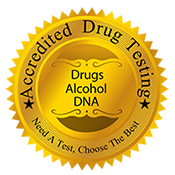
Drug Test/Screening Collector Training & Certification, Petersburg, VA
For
Collection Sites, Medical Facilities, DER's, HR Managers, Safety Managers, Court Personnel, Probation Officers, TPA's
Accredited Drug Testing provides a comprehensive online/web-based Urine Drug Testing Collector Training and Certification course in Petersburg, VA for persons required as part of their responsibilities to perform or supervise urine drug testing specimen collections. The collector training program may be completed with or without the required mock collection proficiency assessments. Upon completion of the training program, students will receive a certificate of successful completion of the training course. In Petersburg, VA to be qualified/certified as a DOT urine drug test collector, you must satisfactorily complete both the training course and a minimum of 5 error free proficiency mock demonstrations.
The Drug Test Collector plays a critical role in the workplace drug screening process. Along with the employer, the testing facility and the Medical Review Officer (MRO), the collector is an essential part of a system developed to ensure drug-free workplaces for the sake of public safety.
As the collector, you are the only individual in the drug-testing process who has direct, face-to-face contact with the employee. You ensure the integrity of the urine specimen and collection process and begin the chain of custody that includes the laboratory; the MRO; the employer; and, possibly, the courts.
This training is a professional-level course that provides the knowledge and skills to qualify Drug Test Collectors to perform U.S. Department of Transportation-regulated drug tests and non-regulated tests. Course participants also have the option of becoming professionally certified after completion of this course. This designation confirms that the collector is committed to the highest standards in the drug and alcohol testing industry.
The Course
This professional-level course meets the regulatory standards of U.S. Department of Transportation (DOT) rule 49 CFR Part 40 and provides a solid foundation for a wide range of testing programs.
- Library of terms & resources
- Universal skills set
- Multiple industries
- Lessons
- DOT Qualification
- Public sector
- Short quizzes & final examination
- Professional Certification
- Private sector
- Mock collections
- Regulated by local, state and federal authorities
- Signature
How to become a DOT Qualified Urine Collector?
To become qualified as a collector, you must be knowledgeable about Part 40 regulations, the current "DOT Urine Specimen Collection Procedures Guidelines," and DOT agency regulations applicable to the employers for whom you will perform collections, and you must keep current on any changes to these materials. You must also (1) successfully complete a qualification training program and (2) pass a monitored proficiency demonstration, as required by DOT regulations [See 49 CFR Part 40.33 (b-c), effective August 1, 2001]. Please note: there is no "grandfather" clause or waiver from this requirement. A collector's qualifications are not location/collection site specific, and their eligibility will follow them anywhere DOT Agency regulated urine specimens are collected. There is no requirement for qualified collectors to register or to be on any federally-maintained or federally-sponsored list, but they are required to maintain (for Federal inspection) documentation of successful completion of their training and proficiency demonstration requirements.
How to Take the Course
The Drug Test Collector Training involves multiple parts that need to be completed in a specific order to achieve certification.
- Before starting the training, the collector must:
- review 49 CFR Part 40 and be familiar with the regulatory language;
- review the DOT Urine Specimen Collection Guidelines;
- review "Instructions for Completing the Federal Drug Testing Custody and Control Form for Urine Specimen Collection"
- watch DOT's 10 Steps to Collection Site Security and Integrity video.
- and download the sample Custody and Control Form. This form guides the entire drug-collection process. Review the document and have it at hand through the entire course. (All required materials are also available in the Reference Library.) NOTE: The 2017 version of the CCF is no longer current. If you intend to use it, you must attach a Memorandum for Record (MFR).
- Take the course Pre-Test to show familiarity with the subject matter based on a review of the materials provided.
- Complete the lessons of the training along with the required short quizzes.
- Take the final exam. A score of at least 90 percent is required.
- When you pass the online portion of this training, continue to the Next Steps lesson for instructions on how to set up five mock collections with a live examiner. These must be scheduled within 30 days of course completion and are required for qualification and certification.
- Once the mock collections are completed without error, you will be qualified and can perform both federally regulated and non-regulated drug test collections.
- To be certified, qualified collectors are asked to sign an agreement promising to adhere to the standards set in the training. The course administrator will then issue a certification form documenting that the collector is both a USDOT Qualified and Professionally Certified Drug Testing Collector. Contact the course administrator for more information.
Additional Courses Available
- DOT Alcohol Screening Test Technician Training
- Saliva/Oral Fluid Training & Certification
- Certified Drug Test Collector Annual Exam
- DOT Breath Alcohol Technician Training
- Hair Specimen Collector Training & Certification
- DOT Reasonable Suspicion Training Course
- DER Training FMCSA
- DER Training FAA
- DER Training PHMSA
- DER Training FRA
- DER Training FTA
- DER Training USCG
- MRO Assistant Training
- New Business Start Up Overview
** Accredited Drug Testing's Urine Specimen Collector training course is developed in conjunction with the National Drug and Alcohol Screening Association.
Drug and Alcohol Testing Locations Petersburg, VA
0.7 miles
PETERSBURG, VA 23803
1.6 miles
COLONIAL HEIGHTS, VA 23834
1.9 miles
COLONIAL HEIGHTS, VA 23834
2.7 miles
COLONIAL HEIGHTS, VA 23834
3.6 miles
PETERSBURG, VA 23805
3.6 miles
PETERSBURG, VA 23805
3.8 miles
PETERSBURG, VA 23805
7.8 miles
HOPEWELL, VA 23860
8.2 miles
HOPEWELL, VA 23860
8.6 miles
HOPEWELL, VA 23860
12.1 miles
RICHMOND, VA 23237
15.0 miles
RICHMOND, VA 23234
16.7 miles
MIDLOTHIAN, VA 23112
18.7 miles
RICHMOND, VA 23231
19.1 miles
RICHMOND, VA 23231
20.2 miles
Midlothian, VA 23112
20.4 miles
RICHMOND, VA 23231
21.0 miles
RICHMOND, VA 23225
Were you looking, instead, for:
All Rights Reserved
Local Area Info: Petersburg, Virginia
Petersburg is an independent city in the Commonwealth of Virginia in the United States. As of the 2010 census, the population was 32,420. The Bureau of Economic Analysis combines Petersburg (along with the city of Colonial Heights) with Dinwiddie County for statistical purposes. It is located on the Appomattox River (a tributary of the longer larger James River flowing east to meet the southern mouth of the Chesapeake Bay at the Hampton Roads harbor and the Atlantic Ocean). The city is just 21 miles (34 km) south of the historic commonwealth (state) capital city of Richmond. The city's unique industrial past and its location as a transportation hub combined to create wealth for Virginia and the Middle Atlantic and Upper South regions of the nation.
Early in the colonial era of the 18th century, Petersburg was the final destination on the Upper Appomattox Canal Navigation System because of its location on the Appomattox River with its connection to the James River to the east at the Atlantic Seaboard fall line (the head of navigation of rivers on the U.S. East Coast) and the tying in with the James River shipping traffic was a strategic place for transportation and commercial activities. It connected commerce as far inland as Farmville, Virginia at the foothills of the Blue Ridge and the Appalachian Mountains chain, to shipping further east into the Chesapeake Bay and North Atlantic Ocean. For similar reasons, 17th century era Fort Henry was built at the order of the Virginia House of Burgesses at Petersburg in 1645 to protect the river traffic.
As railroads were being constructed and extended in the state in the 1830s and 1840s, Petersburg was developed as a major transfer point for both north-south and east-west competitors. The Petersburg Railroad, authorized in 1830, three years after the first American railway, the B.& O. in Baltimore, by the state legislstures of both Virginia and North Carolina to the south, which opened in 1833. It was another one of the earliest predecessors of the modern-day CSX Transportation system. Several of the earliest predecessors of the area's other major Class 1 railroad, the Norfolk Southern, also met at Petersburg. Access to railroads stimulated industry in the city, which was already established because of the water power available at the fall line, as the river plunged from the Piedmont level to lower tidewater lands.

